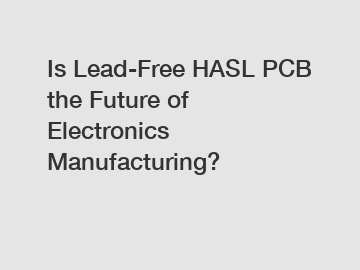Is Lead-Free HASL PCB the Future of Electronics Manufacturing?
Is Lead-Free HASL PCB the Future of Electronics Manufacturing?
In recent years, the electronics manufacturing industry has been increasingly focused on sustainability and environmental responsibility. As a result, the use of lead in the manufacturing process has been significantly reduced and even banned in certain regions. Lead-Free HASL (Hot Air Solder Leveling) PCB has emerged as a potential alternative that not only meets these new regulations but also offers several other benefits. This article aims to explore the question of whether Lead-Free HASL PCB is indeed the future of electronics manufacturing.
The move towards Lead-Free HASL PCB has gained traction due to several reasons. Firstly, lead is an environmentally toxic substance that can have harmful effects on human health and the environment. By eliminating lead from the manufacturing process, we can contribute to a cleaner and safer world. Additionally, Lead-Free HASL PCB is more compatible with modern technology and can withstand higher temperatures, providing better reliability and performance. This is especially crucial in industries such as aerospace and automotive, where demanding operating conditions require robust and durable circuit boards.

Furthermore, the adoption of Lead-Free HASL PCB is in line with international regulations and standards. Many countries have implemented strict regulations regarding the use of lead in electronic products, such as the Restriction of Hazardous Substances (RoHS) directive in the European Union. By using Lead-Free HASL PCB, manufacturers can ensure compliance with these regulations and expand their market reach globally. This is particularly important for companies looking to export their products to regions with stringent environmental policies.
In terms of manufacturing processes, Lead-Free HASL PCB offers several advantages. The hot air solder leveling method used in the production of Lead-Free HASL PCB is a well-established and widely used technique. This means that manufacturers don't need to invest in expensive equipment or undergo significant process changes. The transition to Lead-Free HASL PCB can be a smooth and cost-effective process, allowing manufacturers to quickly adapt to the new requirements and maintain a competitive edge in the industry.
The adoption of Lead-Free HASL PCB also brings significant benefits to end-users. Lead-Free HASL PCBs are more resistant to corrosion and have a longer lifespan compared to traditional lead-based PCBs. This means that electronic devices using Lead-Free HASL PCBs are more reliable and less likely to fail prematurely. Moreover, the elimination of lead from electronic products ensures that there are no harmful substances present, making them safer for consumers to use.
In conclusion, Lead-Free HASL PCB holds great potential as the future of electronics manufacturing. Its compatibility with modern technology, environmental benefits, regulatory compliance, and ease of implementation make it an attractive option for manufacturers. Furthermore, the improved reliability and safety it offers to end-users cannot be overlooked. As the electronics manufacturing industry continues to prioritize sustainability and compliance, the adoption of Lead-Free HASL PCB is expected to become more widespread, shaping the future of the industry for years to come.
For more information, please visit immersion tin 4layer , Industrial Control PCB Manufacturer, automotive pcb design .
217
0
0

Comments
All Comments (0)